Apparatus and method for maintaining patency in a vessel adjacent to nearby surgery
Horgan , et al. Oc
U.S. patent number 10,456,283 [Application Number 15/648,670] was granted by the patent office on 2019-10-29 for apparatus and method for maintaining patency in a vessel adjacent to nearby surgery. This patent grant is currently assigned to BOSTON SCIENTIFIC SCIMED, INC.. The grantee listed for this patent is BOSTON SCIENTIFIC SCIMED, INC.. Invention is credited to Fergal Horgan, Adrian McNamara, Fionnuala O'Gorman.
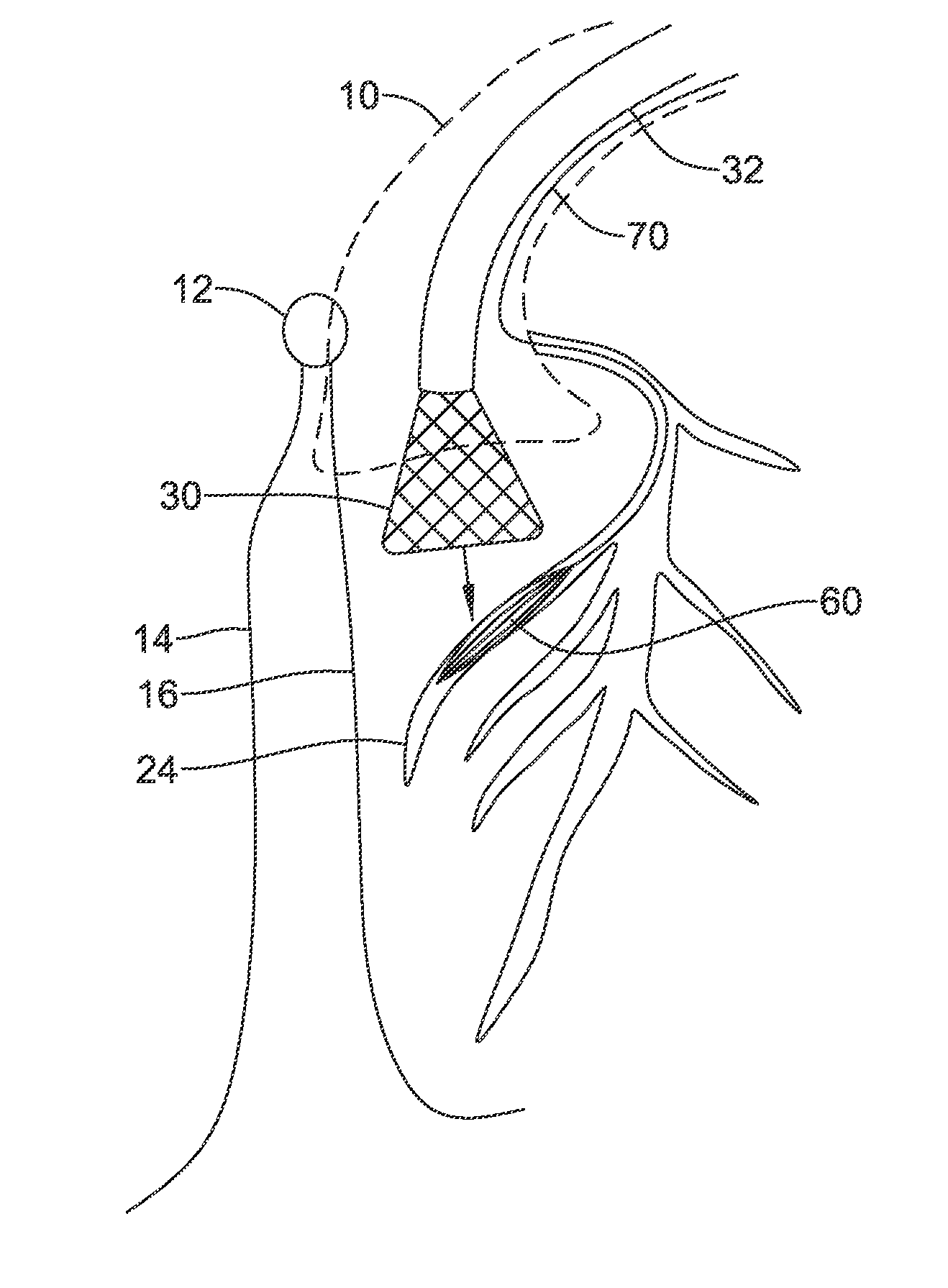
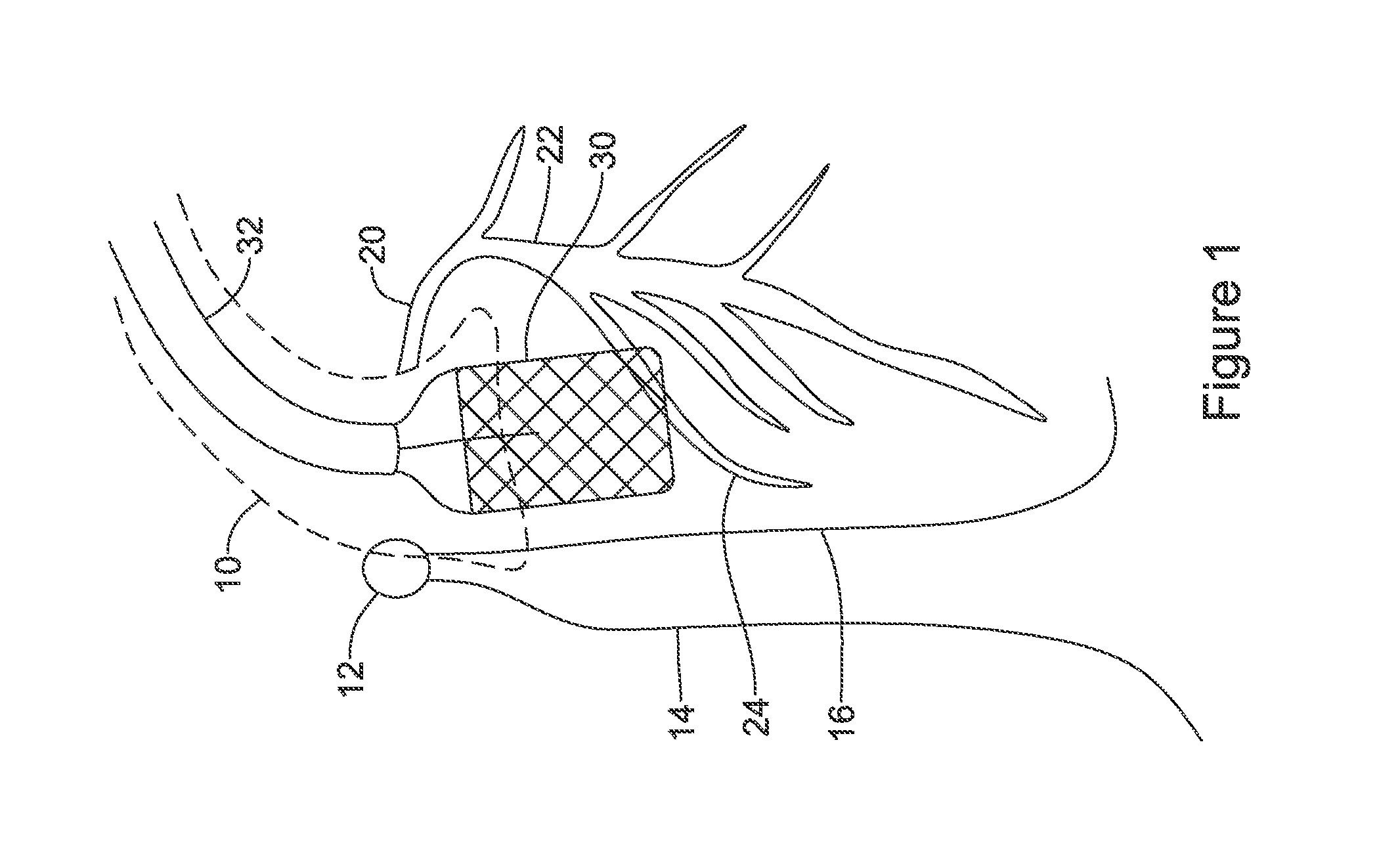
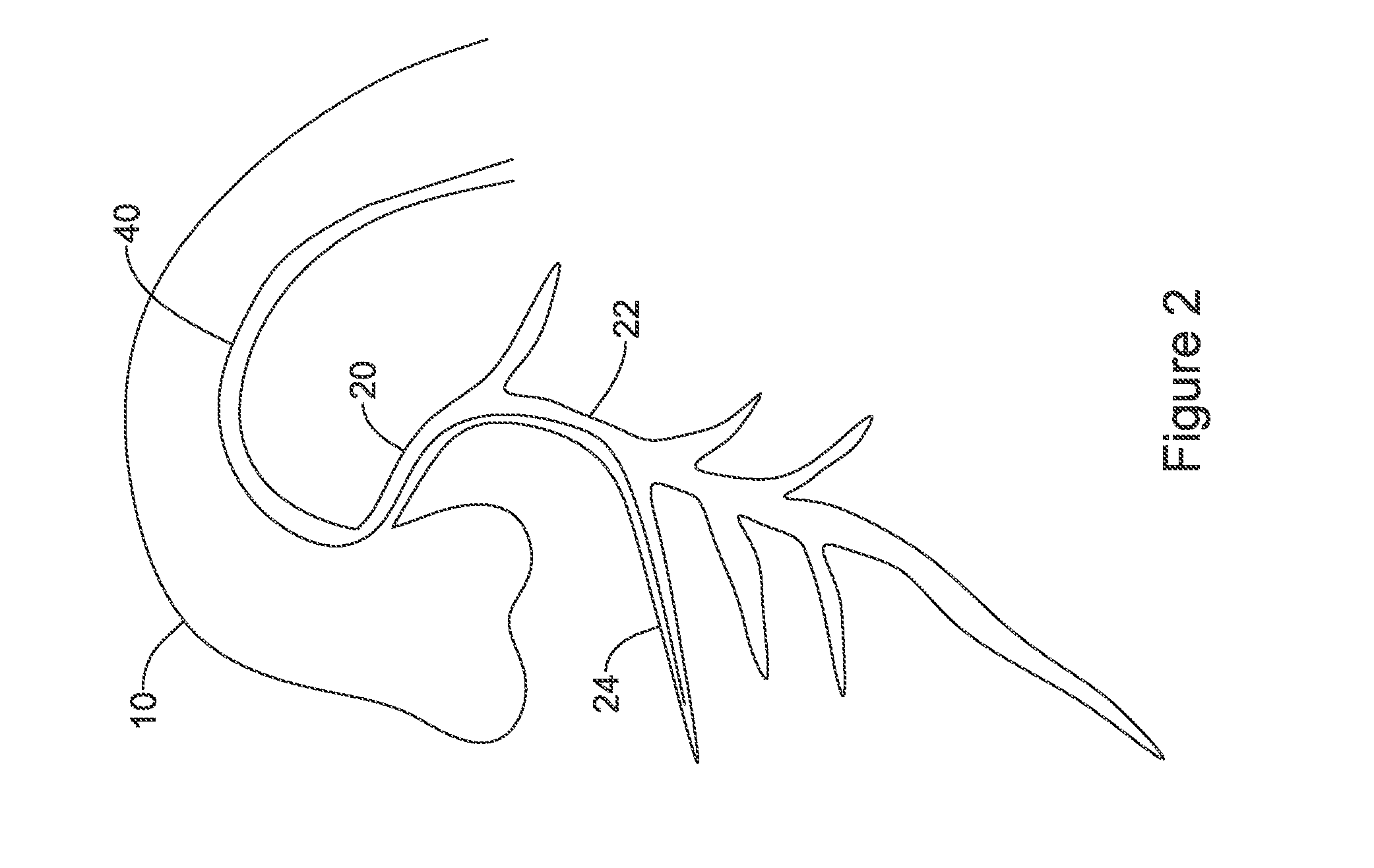

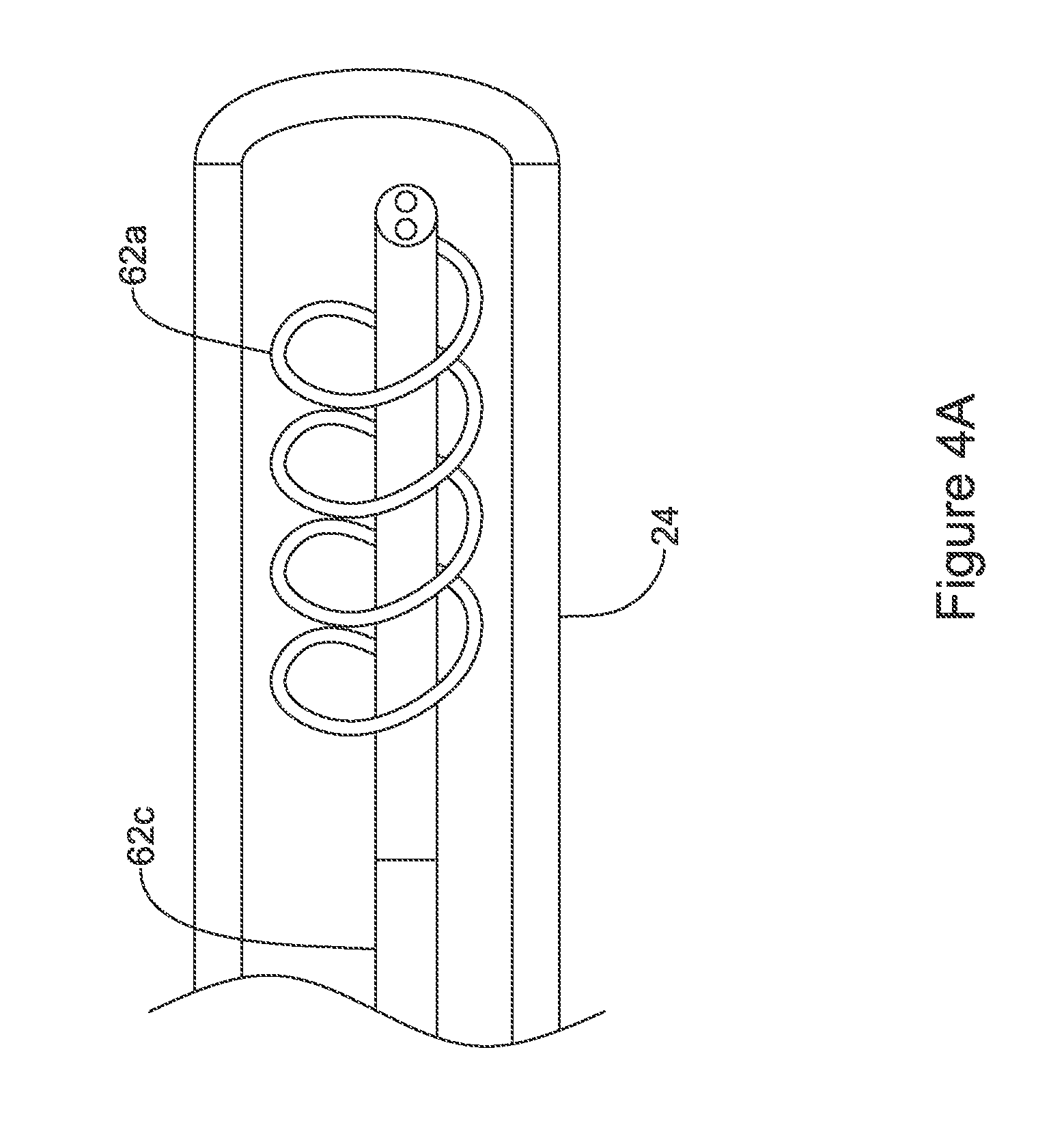
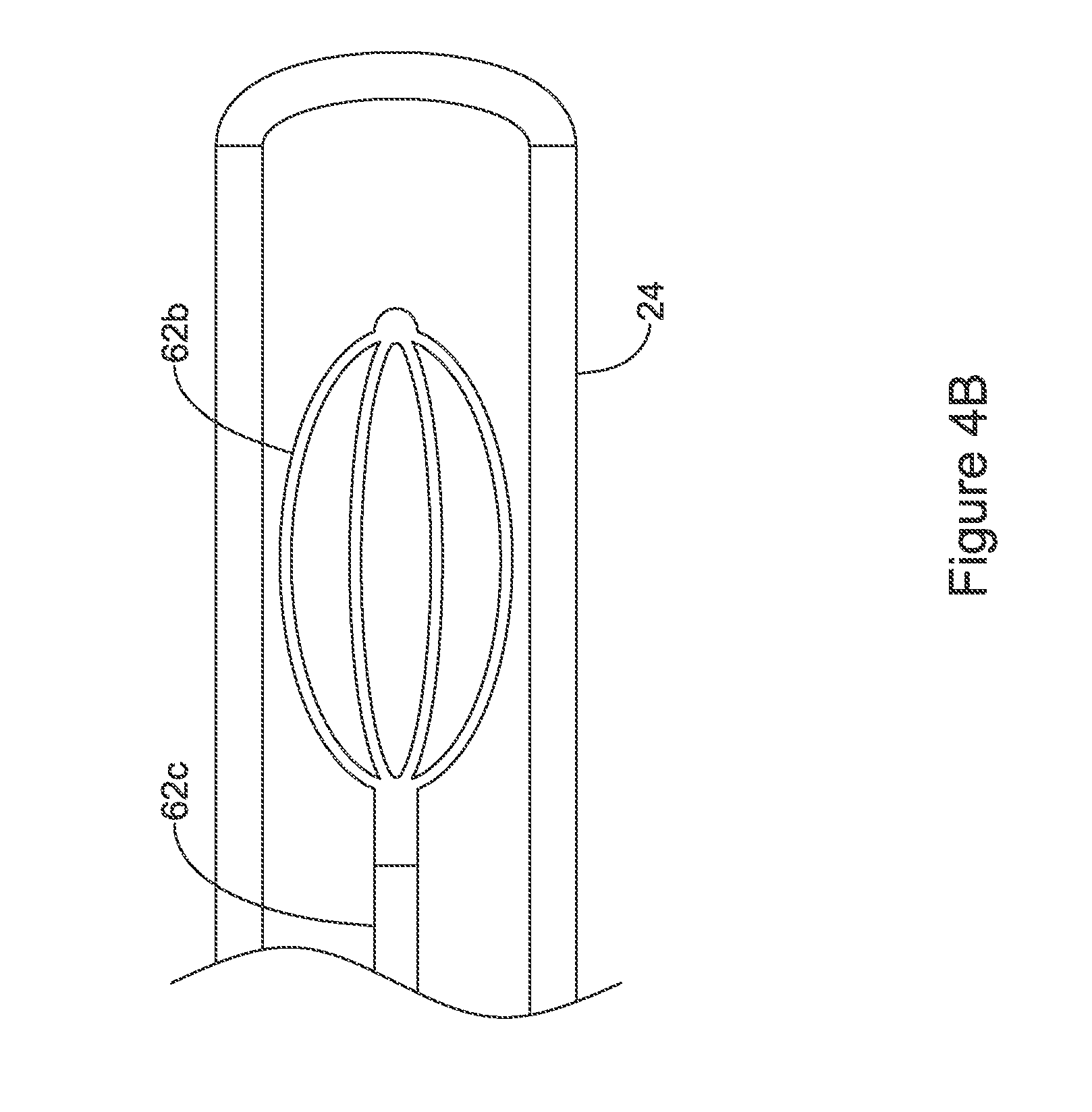

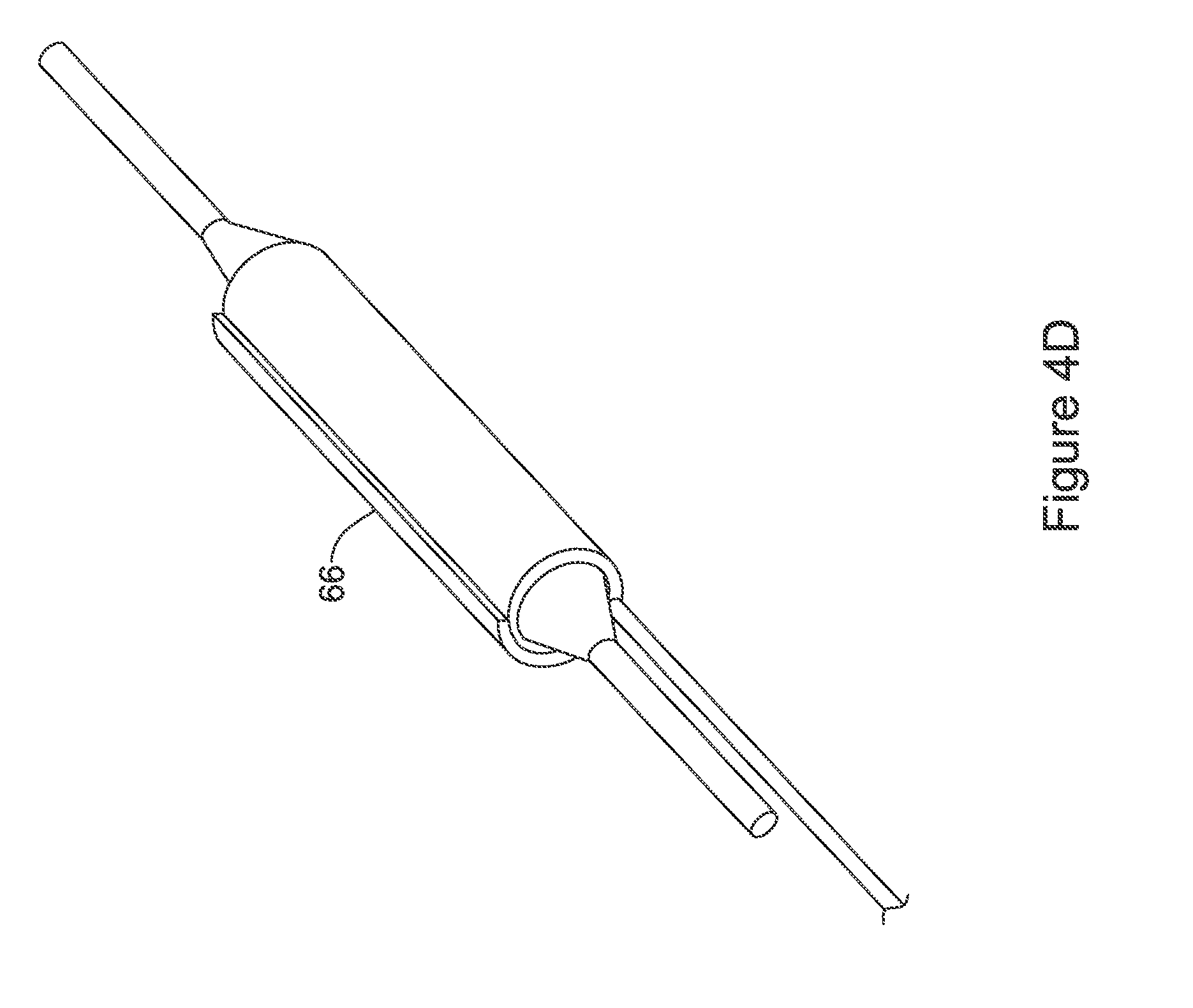
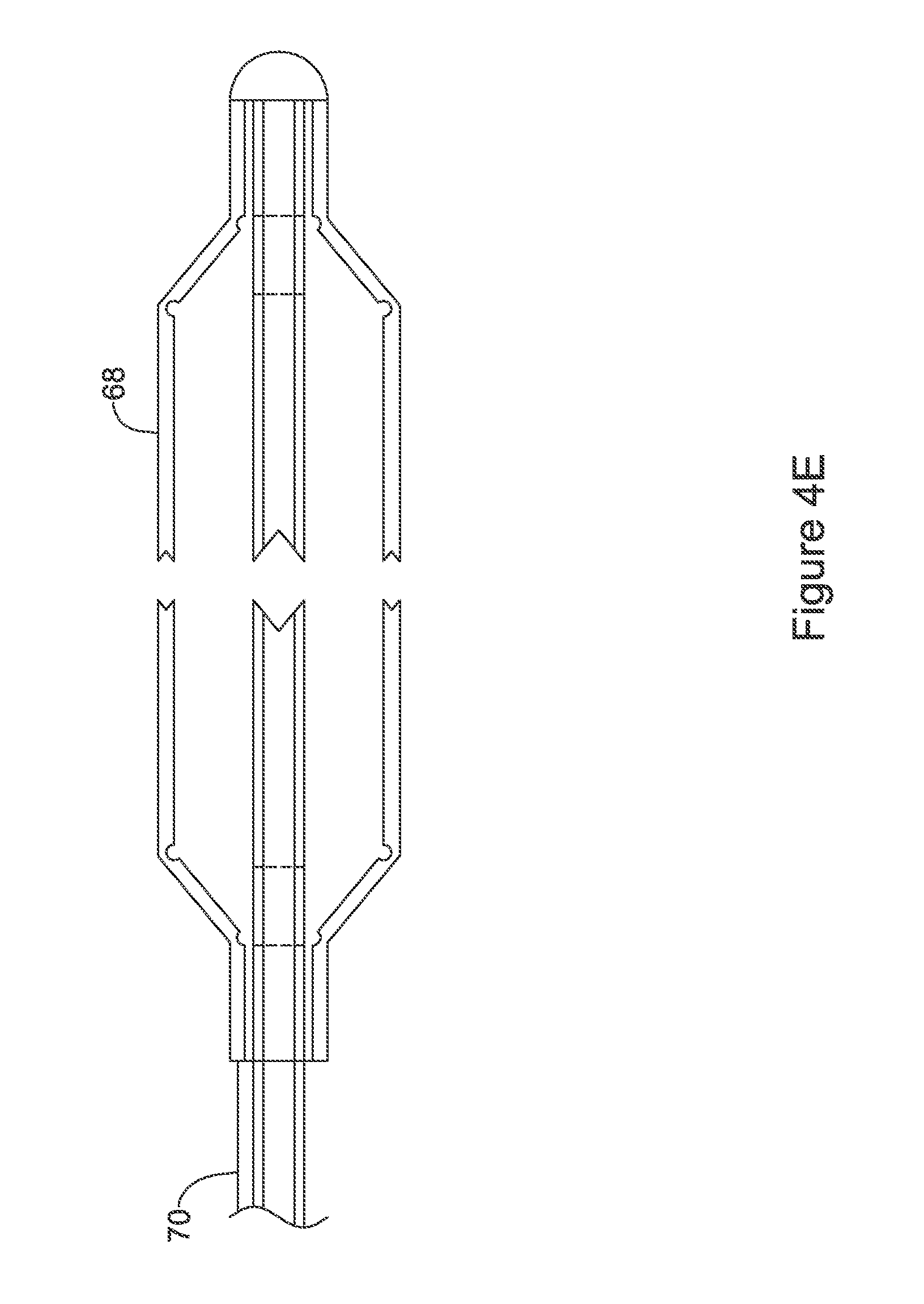
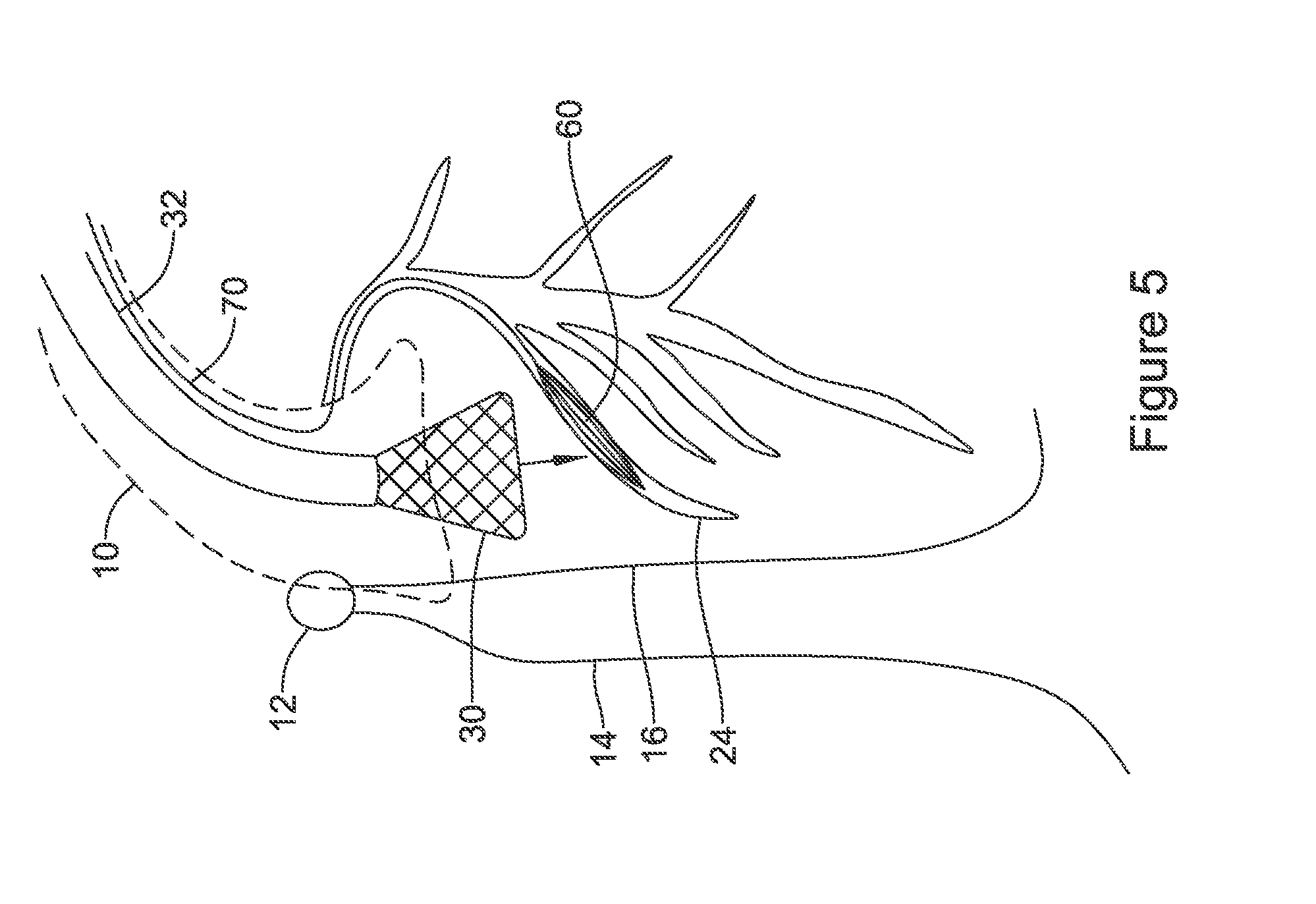

| United States Patent | 10,456,283 |
| Horgan , et al. | October 29, 2019 |
Apparatus and method for maintaining patency in a vessel adjacent to nearby surgery
Abstract
The disclosure pertains to an apparatus for maintaining patency within vessels in the vicinity of surgical procedures which might otherwise be compressed and partially or totally occluded and methods of use therefor.
| Inventors: | Horgan; Fergal (Co. Mayo, IE), McNamara; Adrian (Galway, IE), O'Gorman; Fionnuala (Dublin, IE) | ||||||||||
|---|---|---|---|---|---|---|---|---|---|---|---|
| Applicant: |
|
||||||||||
| Assignee: | BOSTON SCIENTIFIC SCIMED, INC.
(Maple Grove, MN) |
||||||||||
| Family ID: | 59384260 | ||||||||||
| Appl. No.: | 15/648,670 | ||||||||||
| Filed: | July 13, 2017 |
Prior Publication Data
| Document Identifier | Publication Date | |
|---|---|---|
| US 20180014956 A1 | Jan 18, 2018 | |
Related U.S. Patent Documents
| Application Number | Filing Date | Patent Number | Issue Date | ||
|---|---|---|---|---|---|
| 62361655 | Jul 13, 2016 | ||||
| Current U.S. Class: | 1/1 |
| Current CPC Class: | A61F 2/844 (20130101); A61F 2/95 (20130101); A61F 2/2427 (20130101); A61F 2002/9528 (20130101); A61F 2/9522 (20200501); A61F 2250/0003 (20130101); A61M 25/04 (20130101) |
| Current International Class: | A61F 2/95 (20130101); A61F 2/844 (20130101); A61F 2/24 (20060101); A61M 25/04 (20060101) |
References Cited [Referenced By]
U.S. Patent Documents
| 4545390 | October 1985 | Leary |
| 4601705 | July 1986 | McCoy |
| 4650466 | March 1987 | Luther |
| 4777951 | October 1988 | Cribier et al. |
| 4819751 | April 1989 | Shimada et al. |
| 4986830 | January 1991 | Owens et al. |
| 5041093 | August 1991 | Chu |
| 5222971 | June 1993 | Willard et al. |
| 5309896 | May 1994 | Moll |
| 5449372 | September 1995 | Schmaltz et al. |
| 5554181 | September 1996 | Das |
| 5626602 | May 1997 | Gianotti et al. |
| 5906590 | May 1999 | Hunjan et al. |
| 5980533 | November 1999 | Holman |
| 6013019 | January 2000 | Fischell et al. |
| 6027516 | February 2000 | Kolobow et al. |
| 6059752 | May 2000 | Segal |
| 6066149 | May 2000 | Samson et al. |
| 6162237 | December 2000 | Chan |
| 6187054 | February 2001 | Colone et al. |
| 6231598 | May 2001 | Berry |
| 6368344 | April 2002 | Fitz |
| 6383205 | May 2002 | Samson et al. |
| 6398758 | June 2002 | Jacobsen et al. |
| 6458151 | October 2002 | Saltiel |
| 6494907 | December 2002 | Bulver |
| 6514273 | February 2003 | Voss et al. |
| 6540768 | April 2003 | Diaz et al. |
| 6562064 | May 2003 | deBeer |
| 6572648 | June 2003 | Klumb et al. |
| 6616689 | September 2003 | Ainsworth |
| 6645237 | November 2003 | Klumb et al. |
| 6660032 | December 2003 | Klumb et al. |
| 6673042 | January 2004 | Samson et al. |
| 6921414 | July 2005 | Klumb et al. |
| 6991641 | January 2006 | Diaz et al. |
| 7004954 | February 2006 | Voss et al. |
| 7128752 | October 2006 | Bales |
| 7618432 | November 2009 | Pedersen et al. |
| 7744620 | June 2010 | Pedersen et al. |
| 7766871 | August 2010 | Hirszowicz et al. |
| 7875050 | January 2011 | Samson et al. |
| 7931664 | April 2011 | Gray |
| 7951111 | May 2011 | Drasler et al. |
| 7951186 | May 2011 | Eidenschink et al. |
| 7996993 | August 2011 | Gray |
| 8057396 | November 2011 | Forster et al. |
| 8066757 | November 2011 | Ferrera et al. |
| 8070791 | December 2011 | Ferrera et al. |
| 8088140 | January 2012 | Ferrera et al. |
| 8100935 | January 2012 | Rosenbluth et al. |
| 8192479 | June 2012 | Paul, Jr. |
| 8197493 | June 2012 | Ferrera et al. |
| 8361016 | January 2013 | Siegel et al. |
| 8366737 | February 2013 | Hancock et al. |
| 8406867 | March 2013 | Kassab |
| 8460368 | June 2013 | Taylor et al. |
| 8486014 | July 2013 | Kelly et al. |
| 8486025 | July 2013 | Solar et al. |
| 8486102 | July 2013 | Pedersen et al. |
| 8486104 | July 2013 | Samson et al. |
| 8491614 | July 2013 | LeMaitre et al. |
| 8574247 | November 2013 | Adams et al. |
| 8574262 | November 2013 | Ferrera et al. |
| 8585594 | November 2013 | Forster et al. |
| 8585713 | November 2013 | Ferrera et al. |
| 8623074 | January 2014 | Ryan |
| 8632559 | January 2014 | Gershony et al. |
| 8652099 | February 2014 | Fierens et al. |
| 8679142 | March 2014 | Slee et al. |
| 8709075 | April 2014 | Adams et al. |
| 8784467 | July 2014 | Connelly et al. |
| 8784480 | July 2014 | Taylor et al. |
| 8808237 | August 2014 | Thielen et al. |
| 8828040 | September 2014 | Goff |
| 8900264 | December 2014 | Drasler et al. |
| 8926680 | January 2015 | Ferrera et al. |
| 8945143 | February 2015 | Ferrera et al. |
| 8945172 | February 2015 | Ferrera et al. |
| 9005139 | April 2015 | Klaiman et al. |
| 9034025 | May 2015 | Sanati et al. |
| 9044618 | June 2015 | Hawkins et al. |
| 9044619 | June 2015 | Hawkins et al. |
| 9050441 | June 2015 | Solar et al. |
| 9161834 | October 2015 | Taylor et al. |
| 9198687 | December 2015 | Fulkerson et al. |
| 9216082 | December 2015 | Von Segesser et al. |
| 9220521 | December 2015 | Hawkins et al. |
| 9232961 | January 2016 | LeMaitre et al. |
| 9242081 | January 2016 | Drasler et al. |
| 9289224 | March 2016 | Adams et al. |
| 9289581 | March 2016 | Magnuson et al. |
| 9339230 | May 2016 | Kassab |
| 9351756 | May 2016 | Gershony et al. |
| 9364254 | June 2016 | Gershony et al. |
| 9375555 | June 2016 | Pedersen et al. |
| 9387098 | July 2016 | Ferrera et al. |
| 9414852 | August 2016 | Gifford, III et al. |
| 9421025 | August 2016 | Hawkins et al. |
| 9445829 | September 2016 | Brady et al. |
| 9480823 | November 2016 | Roche et al. |
| 9486188 | November 2016 | Secrest et al. |
| 9504807 | November 2016 | Drasler et al. |
| 9545323 | January 2017 | Cully |
| 10195014 | February 2019 | Lamson |
| 2001/0020173 | September 2001 | Klumb et al. |
| 2001/0020182 | September 2001 | Klumb et al. |
| 2001/0044621 | November 2001 | Klumb et al. |
| 2001/0051822 | December 2001 | Stack |
| 2002/0077693 | June 2002 | Barclay et al. |
| 2003/0028245 | February 2003 | Barclay et al. |
| 2003/0225444 | December 2003 | Klumb et al. |
| 2004/0122466 | June 2004 | Bales |
| 2004/0153142 | August 2004 | Klumb et al. |
| 2004/0220604 | November 2004 | Fogarty et al. |
| 2005/0060025 | March 2005 | Mackiewicz |
| 2005/0165412 | July 2005 | Secrest et al. |
| 2005/0273147 | December 2005 | Israel |
| 2006/0020324 | January 2006 | Schmid |
| 2006/0136033 | June 2006 | Hermann et al. |
| 2006/0136034 | June 2006 | Modesitt et al. |
| 2006/0136035 | June 2006 | Hermann et al. |
| 2006/0206125 | September 2006 | Fogarty et al. |
| 2006/0235506 | October 2006 | Ta |
| 2006/0282152 | December 2006 | Beyerlein |
| 2007/0016243 | January 2007 | Ramaiah et al. |
| 2007/0173923 | July 2007 | Savage |
| 2007/0219616 | September 2007 | Modesitt et al. |
| 2007/0239259 | October 2007 | Boylan |
| 2007/0293930 | December 2007 | Wang |
| 2008/0058856 | March 2008 | Ramaiah et al. |
| 2008/0114439 | May 2008 | Ramaiah et al. |
| 2008/0125848 | May 2008 | Kusleika |
| 2010/0070015 | March 2010 | Schneider |
| 2010/0160951 | June 2010 | Madison |
| 2010/0318097 | December 2010 | Ferrera et al. |
| 2011/0082490 | April 2011 | Connelly et al. |
| 2012/0046678 | February 2012 | LeMaitre et al. |
| 2012/0259400 | October 2012 | Von Oepen |
| 2012/0271409 | October 2012 | Bruszewski |
| 2013/0267974 | October 2013 | LeMaitre et al. |
| 2014/0214148 | July 2014 | Shokoohi |
| 2016/0100855 | April 2016 | LeMaitre et al. |
| 2018/0071120 | March 2018 | Sullivan |
| 2747940 | Feb 2013 | CA | |||
Other References
|
International Search Report and Written Opinion dated Sep. 26, 2017 for International Application No. PCT/US2017/041896. cited by applicant. |
Primary Examiner: Dang; Phong Son H
Attorney, Agent or Firm: Seager, Tufte & Wickhem LLP
Parent Case Text
CROSS-REFERENCE TO RELATED APPLICATIONS
This application claims the benefit of priority to U.S. Provisional Application Ser. No. 62/361,655, filed Jul. 13, 2016, the entirety of which is incorporated herein by reference.
Claims
What is claimed is:
1. A method of preserving patency in a non-occluded coronary artery during nearby surgery comprising: advancing a steerable delivery catheter having a retrievable patency maintaining element contained therein in a first compact configuration into a non-occluded coronary artery within a patient within which coronary artery patency is to be preserved; deploying the retrievable patency maintaining element in the non-occluded coronary artery; withdrawing the steerable delivery catheter a predetermined distance from the non-occluded coronary artery within which patency is to be preserved; performing surgery nearby the non-occluded coronary artery within which patency is to be preserved; retrieving the retrievable patency maintaining element from the non-occluded coronary artery using a retrieval mechanism for the retrievable patency maintaining element; removing the retrieval mechanism for the retrievable patency maintaining element from the patient wherein the withdrawing step further includes maintaining a connection between the retrievable patency maintaining element and the steerable delivery catheter or a retrieval mechanism; wherein maintaining a connection between the retrievable patency maintaining element and the steerable delivery catheter or a retrieval mechanism is through at least one of a tether, an activation link, and an inflation tube; and wherein the inflation tube includes a valve adapted to control flow of a fluid during inflation, an implantation interval, and/or deflation of the retrievable patency maintaining element.
2. The method of claim 1, wherein the withdrawing step further includes maintaining a connection between the retrievable patency maintaining element and the steerable delivery catheter or the retrieval mechanism.
3. The method of claim 2, wherein maintaining a connection between the retrievable patency maintaining element and the steerable delivery catheter or the retrieval mechanism is through at least one of a tether, an activation link, and an inflation tube.
4. The method of claim 1, wherein the withdrawing step does not include maintaining contact between the retrievable patency maintaining element and the steerable delivery catheter or the retrieval mechanism.
5. The method of claim 1, wherein the retrieving step includes advancing the retrieval mechanism along the connection between the retrievable patency maintaining element and the steerable delivery catheter or a retrieval mechanism.
6. The method of claim 1, wherein the retrieving step is performed without relying upon a connection between the retrievable patency maintaining element and the retrieval mechanism.
Description
BACKGROUND
In the course of surgical interventions, particularly within the heart, the necessary insertion and manipulation of instruments and prostheses may apply pressure to adjacent structures which, when major blood vessels are located within those structures, may result in temporary partial or complete blockage of the vessels and an attendant risk of tissue damage.
For example during the transcatheter positioning of a replacement aortic valve, displacement of the native valve and/or the expansion of components of the replacement valve may incidentally apply pressure to adjacent cardiac wall tissue and thus to the vessels associated with that tissue. In the instance of aortic valve replacement, pressure may be transmitted to the left anterior descending (LAD) branch of the left coronary artery and in particular to the first septal branch of the LAD which supplies the anterior and superior critical portion of the interventricular conduction system. The blood supply to the left anterior fascicle is narrow and the fascicle is susceptible to ischemic damage and possible conduction disturbances. Damage, if it occurs, may be transient or permanent and may not be immediately apparent.
While stents, including temporary stents and steerable deployment/retrieval systems therefor are known in the art, those stents are deployed in an occluded or partially occluded coronary artery or other vessel and rely for their utility, in part, upon expansion to a diameter greater than the diameter of the vessel and/or an occluding deposit prior to introduction of the stent, the over-expansion being necessary to increase the patency of the vessel in which the stent is to be deployed.
Accordingly, a need exists for methods and appropriate apparatus for preventing, or at least minimizing, restriction of blood flow in the vicinity of surgical interventions.
SUMMARY
In certain aspects, this disclosure pertains to an apparatus for maintaining patency of a non-occluded coronary artery during nearby surgery comprising a retrievable patency maintaining element having a first compact configuration and a second expanded configuration, wherein in the second expanded configuration the retrievable patency maintaining element is sized and adapted to maintain patency of a non-occluded coronary artery while contacting opposed walls of the non-occluded coronary artery without significantly altering a diameter of the non-occluded coronary artery and further wherein the retrievable patency maintaining element is configured and adapted to sufficiently resist external collapsing forces which may be applied to the non-occluded coronary artery during nearby surgery such that patency is maintained; a steerable delivery catheter having a distal lumen sized and adapted to receive the retrievable patency maintaining element in the first compact configuration and to release the retrievable patency maintaining element within the non-occluded coronary artery; and a retrieval mechanism for the retrievable patency maintaining element.
In addition or alternatively invention relates to a method of preserving patency in a non-occluded coronary artery during nearby surgery comprising advancing a steerable delivery catheter having a retrievable patency maintaining element contained therein in a first compact configuration into an non-occluded coronary artery within a patient within which coronary artery patency is to be preserved; deploying the retrievable patency maintaining element in the non-occluded coronary artery, withdrawing the steerable delivery catheter a predetermined distance from the non-occluded coronary artery within which patency is to be preserved; performing surgery nearby the non-occluded coronary artery within which patency is to be preserved; retrieving the retrievable patency maintaining element from the non-occluded coronary artery using a retrieval mechanism for the retrievable patency maintaining element; and removing the retrieval mechanism for the retrievable patency maintaining element from the patient.
BRIEF DESCRIPTION OF DRAWINGS
FIG. 1, illustrates schematically the relationships between the aortic valve and a vessel to be protected against undesirable compression. Throughout the figures, heart tissue has been largely omitted or indicated in phantom for clarity.
FIG. 2 illustrates the placement of a guidewire.
FIG. 3 illustrates an aspect of use of the invention.
FIGS. 4A-4E illustrate exemplary, non-limiting forms of retrievable patency maintaining elements.
FIG. 5 illustrates schematically the function of an implanted temporarily implanted stent of the invention.
FIG. 6 illustrates an aspect of use of the invention.
DETAILED DESCRIPTION
The following description should be read with reference to the drawings wherein like reference numerals indicate like elements throughout the several views. The drawings, which are not necessarily to scale, are not intended to limit the scope of the claimed invention. The detailed description and drawings illustrate exemplary aspects of the claimed invention.
Although some suitable dimensions, ranges and/or values pertaining to various components, features and/or specifications are disclosed, one of skill in the art, informed by the present disclosure, would understand that desired dimensions, ranges and/or values may deviate from those expressly disclosed unless the context clearly indicates an intended limitation.
All numbers are herein assumed to be modified by the term "about." The recitation of numerical ranges by endpoints includes all numbers subsumed within that range (e.g., 1 to 5 includes 1, 1.5, 2, 2.75, 3, 3.80, 4, and 5).
As used in this specification and the appended claims, the singular forms "a", "an", and "the" include the plural referents unless the content clearly dictates otherwise. As used in this specification and the appended claims, the term "or" is generally employed in its sense including "and/or" unless the content clearly dictates otherwise.
It is noted that references in the specification to "an aspect", "some aspects", "other aspects", etc., indicate that the aspect described may include a particular feature, structure, or characteristic, but every aspect may not necessarily include the particular feature, structure, or characteristic. Moreover, such phrases are not necessarily referring to the same aspect. Further, when a particular feature, structure, or characteristic is described in connection with an aspect, it would be within the knowledge of one skilled in the art to effect such feature, structure, or characteristic in connection with other aspects whether or not explicitly described unless clearly stated to the contrary.
For example, the apparatus described herein comprises a steerable delivery catheter, a retrievable patency maintaining element, and a retrieval mechanism for the retrievable patency maintaining element, each of which may be provided in any of several alternative forms. It would be unnecessarily repetitious to attempt to recite each possible combination of the elements suited to provide the respective functions of the claimed elements. Instead, it will be understood that the claimed apparatus comprises a steerable delivery catheter selected from a group of steerable delivery catheters; a retrievable patency maintaining element selected from a group of retrievable patency maintaining elements; and a retrieval mechanism for the retrievable patency maintaining element selected from a group of retrieval mechanisms for the retrievable patency maintaining elements, wherein the steerable delivery catheter is adapted to deliver the selected retrievable patency maintaining element and the retrieval mechanism is adapted to retrieve the selected retrievable patency maintaining element. It will also be understood that the retrieval mechanism may, or may not, be the same as the steerable delivery catheter.
The apparatus of the claims will be described with reference to its use during the implantation of a transcatheter aortic valve replacement and with reference to the utility of the apparatus in maintaining patency of a coronary artery, in particular a non-occluded first septal branch, located in the vicinity of the aorta which might otherwise be adversely compressed during the procedure. FIG. 1 illustrates, somewhat schematically, the implantation of a replacement aortic heart valve using a transcatheter approach. In the figure, the majority of the coronary tissue has been omitted to more clearly show the relative positions of the pertinent structures which include the aorta 10, the atrioventricular node (AV node) 12, the right bundle branch (RBB) 14, the left bundle branch (LBB) 16, the left coronary artery 20, the left anterior descending (LAD) artery 22, and the first septal branch 24 thereof. In addition, the figure illustrates an initial placement of a Transcatheter Aortic Valve Replacement (TAVR) device 30 and the delivery catheter 32 for the TAVR device. Although the intervening tissue has been omitted, it will be seen that the TAVR device may be juxtaposed with the arterial pathway defined by the first septal branch 24 such that incidental contact between the TAVR device 30 and the heart wall may tend to compress the first septal branch 24. Such compression may temporarily restrict or block blood flow through the narrow first septal branch 24 with possible ischemic damage to the septum, the left anterior fascicle and to the anterior and superior critical portion of the interventricular conduction system with possible conduction disturbances. The damage may be transient or permanent. One of ordinary skill in the art is capable of assessing proposed surgical procedures with regard to likelihood that tissue compression around the surgical site will spread from the surgical site and with regard to the risk of damage from temporary compression of tissue around the surgical site and thus will be able to evaluate the term "nearby" as used herein.
In a non-limiting example of an apparatus of the invention and its use, a steerable delivery catheter 50 containing a retrievable patency maintaining element 60 in a first compact configuration may be steered to a non-occluded artery to be protected by being advanced over a guidewire 40 which has previously been advanced through an aorta 10 into a left coronary artery 20 and into a non-occluded first septal branch 24 of a left anterior descending artery 22 (FIGS. 2 and 3). Once the steerable delivery catheter 50 has been positioned within the non-occluded first septal branch 24, a retrievable patency maintaining element 60 of, for example, a type illustrated in FIG. 4A-E may be deployed from a first compact configuration within the distal end of the steerable delivery catheter 50 into the non-occluded first septal branch 24, and there may assume a second expanded configuration when deployed within the non-occluded first septal branch 24. If desired, the steerable delivery catheter 50 may be withdrawn a predetermined distance (as shown in FIG. 3) to a less crowded portion of the aorta 10 or even removed from the patient. In this aspect of the invention, the retrievable patency maintaining element 60 has attached thereto a wire tether 70 which remains accessible to the operator. In some alternate aspects of the invention the steerable deliver catheter 50 may be of sufficiently small cross-section that it may remain within the coronary arteries during a surgical procedure. In other aspects, the retrievable patency maintaining element 60 may be completely detached from the steerable delivery catheter 50.
At this point, a surgical procedure, such as the implantation of a transcatheter aortic valve replacement, may be carried out in the conventional manner. The close proximity of aortic annulus to the ventricular conduction system and the susceptibility of the first septal branch 24 to inadvertent compression due to mechanical interactions before during and after prosthesis implantation, may lead to restricted blood flow and possible ischemic damage to the left anterior fascicle and/or left posterior fascicle with resultant conduction disturbances which may be transient or permanent. The retrievable patency maintaining element 60 resists collapsing forces directed toward the protected artery thereby preventing some or all of the potential ischemic damage to the conduction pathways.
Following the surgical procedure, a retrieval mechanism 80, which may be the steerable delivery catheter 50 or a may be a separate device, is advanced to the retrievable patency maintaining element 60, either directly or over a tether element 70, if present, whereupon the retrievable patency maintaining element 60, may be engaged and removed. Engagement of the retrievable patency maintaining element 60 by the retrieval mechanism 80 may, in some aspects, include withdrawing the retrievable patency maintaining element 60 at least partially within the distal end of the retrieval mechanism 80.
In a further non-limiting example of an apparatus of the invention and its use, a steerable delivery catheter 50 containing a retrievable patency maintaining element 60 in a first compact configuration may be steered to a non-occluded artery, e.g., first septal branch 24 to be protected, by employing a steerable delivery catheter 50 of the type including a flexible tip and one or more push or pull wires. Once the steerable delivery catheter 50 has reached the non-occluded first septal branch 24, a retrievable patency maintaining element 60 of the type illustrated in, for example, FIG. 4A may be deployed within the non-occluded first septal branch 24 by withdrawing the steerable delivery catheter 50, whereupon the retrievable patency maintaining element 60 expands or is expanded to a diameter not more than 10% greater than the nominal diameter of the non-occluded first septal branch 24 prior to the insertion of the retrievable patency maintaining element 60. The steerable delivery catheter 50 may then be further withdrawn a predetermined distance (See FIG. 3) thereby largely clearing the field near the aortic valve so that the implantation of a transcatheter aortic valve replacement device 30, may be carried out in the conventional manner.
As may be seen in FIG. 5, the presence of a retrievable patency maintaining element 60 within first septal branch 24, or other susceptible vessel, reduces or prevents obstruction of the vessel by compression of tissue adjacent to a site of incidental compression of coronary tissue near the non-occluded first septal branch 24 will be resisted, thereby maintaining patency of the non-occluded first septal branch 24.
A steerable delivery catheter 50 of the invention may be actively steered or may be passively steered by being advanced along a previously positioned guidewire 40. An actively steered catheter may, for example, be of the type including a flexible tip and one or more push or pull wires (exemplified by U.S. Pat. No. 5,906,590); of the type including a plurality of thermally activated deflection elements (exemplified by U.S. Pat. No. 4,601,705); of the type employing rotation of a rigid torsional element, such as a bent guidewire, to direct the curved distal end selectively (exemplified by U.S. Pat. No. 4,545,390); and of the type employing electroactive polymers (exemplified by U.S. Pat. No. 7,951,186), each incorporated by reference, among others known in the art.
A suitable retrievable patency maintaining element 60 generally has the form of a temporarily implantable stent of the art which has been adapted for the current purpose by limiting the degree of expansion such that the stent may contact the walls of the unobstructed coronary artery in which it is deployed without significantly altering the diameter of the artery. One of ordinary skill in the art will appreciate that an artery is not significantly altered if the diameter increase is limited to no more than 0%, 1%, 2%, 4%, or 10%. The retrievable patency maintaining element 60 is adapted and configured for the current purpose by the choice of materials and or the inclusion of structure which resists deformation of the retrievable patency maintaining element 60 when external vessel collapsing forces are applied to the region of the vessel containing the retrievable patency maintaining element 60. Structural modifications may include bridging elements which employ tension and/or compression to preserve the generally cylindrical shape of the retrievable patency maintaining element 60.
Non-limiting examples of suitable retrievable patency maintaining elements 60 include a helical balloon 62A (see FIG. 4A), exemplified in U.S. Pat. No. 7,766,871; an inflatable balloon cage 62B (see FIG. 4B), the balloons optionally including a check-valve (not shown) and a detachable inflation lumen 62C; a helical ribbon coil 64 (FIG. 4C), exemplified in, for example, U.S. Pat. No. 6,027,516; a coiled sheet 66 (FIG. 4D), exemplified in, for example, U.S. Pat. No. 6,027,516; an expandable slotted tube 68 (FIG. 4E), exemplified in, for example, U.S. Pat. No. 6,013,019. Other devices such as expandable wire or polymeric braids may also be used. Suitable retrievable patency maintaining elements 60 may be self-expanding or may be actuated to attain their expanded configuration in a conventional manner.
In some aspects, a retrievable patency maintaining element 60 is released within the coronary artery to be protected and held in position by one or more wall engaging features (not shown). In other aspects, a retrieval mechanism 80 may engage a proximal portion of the retrievable patency maintaining element 60 to allow it to be pulled within the retrieval mechanism 80 or may suitably elongate the retrievable patency maintaining element 60 thereby reducing its diameter to allow its removal. In certain aspects, the retrievable patency maintaining element 60 has attached thereto a tether 70 which facilitates retrieval of the retrievable patency maintaining element 60 by guiding a retrieval mechanism 80 to the retrievable patency maintaining element 60 and providing a tensile force adapted to pull the retrievable patency maintaining element 60 within the distal end of the retrieval mechanism 80 or allowing the retrieval mechanism 80 to be advanced over the retrievable patency maintaining element 60. Any of a variety of engagement mechanisms known in the art may be used.
A tether 70, if present, may also serve to maintain the position of the retrievable patency maintaining element 60 within the coronary artery during the surgical procedure. Tether(s) 70, if present may be, for example, a suture, a braid, or a wire.
In yet other aspects, a retrieval mechanism 80 adapted to function with a balloon retrievable patency maintaining element 60 may include a check-valve release or other balloon deflating feature. As noted previously, in certain aspects, the steerable delivery catheter 50 may be configured and adapted to serve as a retrieval mechanism 80.
GLOSSARY OF ELEMENTS OF THE DRAWINGS
10 Aorta
12 Atrioventricular node (AV node)
16 Left bundle branch (LBB)
20 Left coronary artery
22 Left anterior descending (LAD) artery
24 First septal branch artery
30 Transcatheter Aortic Valve Replacement device (TAVR)
32 TAVR device delivery catheter
40 Guidewire
50 Steerable delivery catheter
60 Retrievable patency maintaining element
62A-68 Variations of retrievable patency maintaining element 60
70 Tether
80 Retrieval mechanism
In certain aspects, this disclosure pertains to an apparatus for maintaining patency of a non-occluded coronary artery during nearby surgery comprising a retrievable patency maintaining element having a first compact configuration and a second expanded configuration, wherein in the second expanded configuration the retrievable patency maintaining element is sized and adapted to maintain patency of a non-occluded coronary artery while contacting opposed walls of the non-occluded coronary artery without significantly altering a diameter of the non-occluded coronary artery and further wherein the retrievable patency maintaining element is configured and adapted to sufficiently resist external collapsing forces which may be applied to the non-occluded coronary artery during nearby surgery such that patency is maintained; a steerable delivery catheter having a distal lumen sized and adapted to receive the retrievable patency maintaining element in the first compact configuration and to release the retrievable patency maintaining element within the non-occluded coronary artery; and a retrieval mechanism for the retrievable patency maintaining element.
In addition or alternatively the invention relates to an apparatus, wherein the steerable delivery catheter employs an initially positioned guidewire which serves to steer the steerable delivery catheter to a deployment site.
In addition or alternatively the invention relates to an apparatus, wherein the steerable delivery catheter employs a catheter which has a deflectable tip.
In addition or alternatively the invention relates to an apparatus, wherein the steerable delivery catheter and the retrieval mechanism are the same catheter.
In addition or alternatively the invention relates to an apparatus, wherein the steerable delivery catheter and the retrieval mechanism are different catheters.
In addition or alternatively the invention relates to an apparatus, wherein the retrievable patency maintaining element maintains a connection to the steerable delivery catheter during the nearby surgery.
In addition or alternatively the invention relates to an apparatus, wherein the retrievable patency maintaining element maintains a connection to the steerable delivery catheter through at least one of a tether, an activation link, and an inflation tube.
In addition or alternatively the invention relates to an apparatus, wherein the tether or the activation link is a suture, a braid, or a wire.
In addition or alternatively the invention relates to an apparatus, wherein the retrievable patency maintaining element maintains a connection to the retrieval mechanism during the nearby surgery.
In addition or alternatively the invention relates to an apparatus, wherein the retrievable patency maintaining element maintains a connection to the retrieval mechanism through at least one of a tether, an activation link, and an inflation tube.
In addition or alternatively the invention relates to an apparatus, wherein the tether or the activation link is a suture, a braid, or a wire.
In addition or alternatively the invention relates to an apparatus, wherein retrievable patency maintaining element is an inflatable element which includes a check valve.
In addition or alternatively the invention relates to an apparatus, wherein retrievable patency maintaining element is an expandable helical wire stent.
In addition or alternatively the invention relates to an apparatus, wherein retrievable patency maintaining element is an expandable laser cut tubular stent.
In addition or alternatively the invention relates to an apparatus, wherein retrievable patency maintaining element is an initially coiled sheet of an elastomeric material.
In addition or alternatively the invention relates to an apparatus for maintaining patency of a non-occluded coronary artery during nearby surgery comprising a retrievable patency maintaining element having a first compact configuration and a second expanded configuration, wherein in the second expanded configuration the retrievable patency maintaining element is sized and adapted to maintain patency of a non-occluded coronary artery while contacting opposed walls of the non-occluded coronary artery without significantly altering a diameter of the non-occluded coronary artery and further wherein the retrievable patency maintaining element is configured and adapted to sufficiently resist external collapsing forces which may be applied to the non-occluded coronary artery during nearby surgery such that patency is maintained; a steerable delivery catheter having a distal lumen sized and adapted to receive the retrievable patency maintaining element in the first compact configuration and to release the retrievable patency maintaining element within the non-occluded coronary artery; and a retrieval mechanism for the retrievable patency maintaining element.
In addition or alternatively the invention relates to an apparatus, wherein the retrievable patency maintaining element maintains a connection to the retrieval mechanism during the nearby surgery.
In addition or alternatively the invention relates to an apparatus, wherein the retrievable patency maintaining element maintains a connection to the retrieval mechanism through at least one of a tether, an activation link, and an inflation tube.
In addition or alternatively the invention relates to an apparatus, wherein the tether or the activation link is a suture, a braid, or a wire.
In addition or alternatively the invention relates to an apparatus, wherein the inflation tube includes a valve adapted to control flow of fluid during inflation, an implantation interval, and/or deflation of the retrievable patency maintaining element.
In addition or alternatively the invention relates to an apparatus, wherein the retrievable patency maintaining element is expanded from the first compact configuration to the second expanded configuration by at least one of relative motion between the tether and the steerable delivery catheter; relative motion between the activation link and the steerable delivery catheter; and introduction of a fluid through the inflation tube and a valve.
In addition or alternatively the invention relates to an apparatus, wherein the retrievable patency maintaining element is self-expanding from the first compact configuration to the second expanded configuration.
In addition or alternatively the invention relates to an apparatus, wherein the retrievable patency maintaining element is formed from a shape memory material.
In addition or alternatively the invention relates to an apparatus, wherein the shape memory material is Nitinol.
In addition or alternatively the invention relates to an apparatus, wherein the retrievable patency maintaining element is a balloon.
In addition or alternatively the invention relates to an apparatus, wherein the retrievable patency maintaining element is a collapsible cage-like structure.
In addition or alternatively the invention relates to an apparatus, wherein the steerable delivery catheter includes the retrieval mechanism for the retrievable patency maintaining element.
In addition or alternatively the invention relates to a method of preserving patency in a non-occluded coronary artery during nearby surgery comprising advancing a steerable delivery catheter having a retrievable patency maintaining element contained therein in a first compact configuration into an non-occluded coronary artery within a patient within which coronary artery patency is to be preserved; deploying the retrievable patency maintaining element in the non-occluded coronary artery, withdrawing the steerable delivery catheter a predetermined distance from the non-occluded coronary artery within which patency is to be preserved; performing surgery nearby the non-occluded coronary artery within which patency is to be preserved; retrieving the retrievable patency maintaining element from the non-occluded coronary artery using a retrieval mechanism for the retrievable patency maintaining element; and removing the retrieval mechanism for the retrievable patency maintaining element from the patient.
In addition or alternatively the invention relates to a method of preserving patency in a non-occluded coronary artery during nearby surgery, wherein the withdrawing step further includes maintaining a connection between the retrievable patency maintaining element and the steerable delivery catheter or a retrieval mechanism.
In addition or alternatively the invention relates to a method of preserving patency in a non-occluded coronary artery during nearby surgery, wherein maintaining a connection between the retrievable patency maintaining element and the steerable delivery catheter or a retrieval mechanism is through at least one of a tether, an activation link, and an inflation tube.
In addition or alternatively the invention relates to a method of preserving patency in a non-occluded coronary artery during nearby surgery, wherein the tether or the activation link is a suture, a braid, or a wire.
In addition or alternatively the invention relates to a method of preserving patency in a non-occluded coronary artery during nearby surgery, wherein the inflation tube includes a valve adapted to control flow of a fluid during inflation, an implantation interval, and/or deflation of the retrievable patency maintaining element.
In addition or alternatively the invention relates to a method of preserving patency in a non-occluded coronary artery during nearby surgery, wherein the withdrawing step does not include maintaining contact between the retrievable patency maintaining element and the steerable delivery catheter or a retrieval mechanism.
In addition or alternatively the invention relates to a method of preserving patency in a non-occluded coronary artery during nearby surgery, wherein the retrieving step includes advancing the retrieval mechanism along the connection between the retrievable patency maintaining element and the steerable delivery catheter or a retrieval mechanism.
In addition or alternatively the invention relates to a method of preserving patency in a non-occluded coronary artery during nearby surgery, wherein the retrieving step is performed without relying upon a connection between the retrievable patency maintaining element and the retrieval mechanism.
Although the illustrative examples described above relate to cardiac surgery and in particular to surgery in the vicinity of an aortic valve, the use of the methods and apparatus disclosed in other tissue is also contemplated.
Various modifications and alterations of this invention will become apparent to those skilled in the art without departing from the scope and principles of this invention, and it should be understood that this invention is not to be unduly limited to the illustrative embodiments set forth hereinabove. All publications and patents are herein incorporated by reference to the same extent as if each individual publication or patent was specifically and individually indicated to be incorporated by reference.
* * * * *
D00000

D00001

D00002

D00003

D00004

D00005

D00006

D00007

D00008

D00009

D00010

XML
uspto.report is an independent third-party trademark research tool that is not affiliated, endorsed, or sponsored by the United States Patent and Trademark Office (USPTO) or any other governmental organization. The information provided by uspto.report is based on publicly available data at the time of writing and is intended for informational purposes only.
While we strive to provide accurate and up-to-date information, we do not guarantee the accuracy, completeness, reliability, or suitability of the information displayed on this site. The use of this site is at your own risk. Any reliance you place on such information is therefore strictly at your own risk.
All official trademark data, including owner information, should be verified by visiting the official USPTO website at www.uspto.gov. This site is not intended to replace professional legal advice and should not be used as a substitute for consulting with a legal professional who is knowledgeable about trademark law.